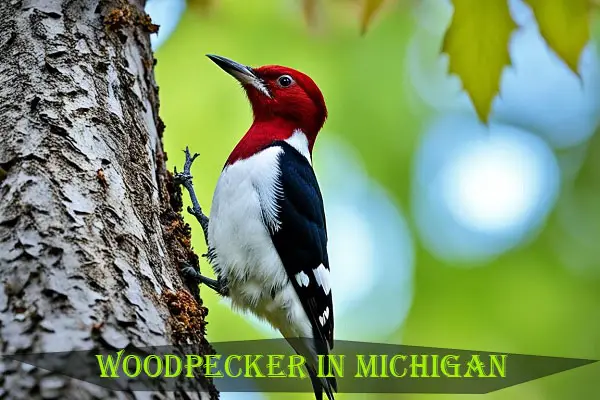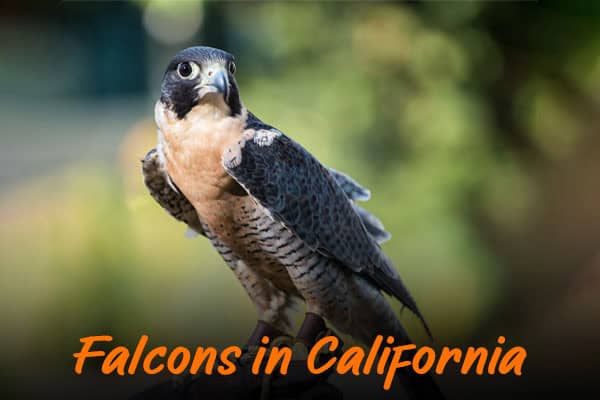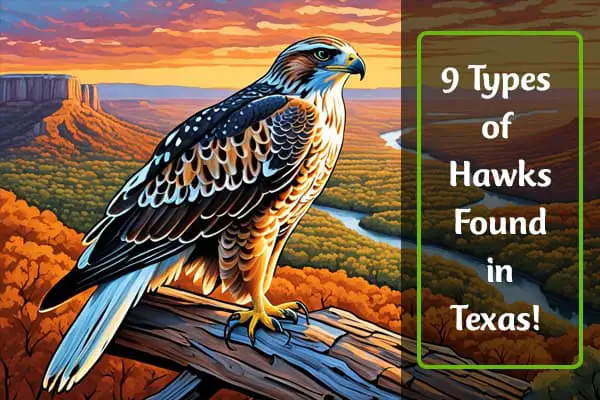7 Types of Woodpeckers in Michigan (With Images)
Do you love Woodpeckers In Michigan? If you say yes, let’s dive into their amazing world. Michigan is home to 7 woodpecker species. Eight of them live here all year, and three visit sometimes.
These birds range from the tiny Downy Woodpecker to the big Pileated Woodpecker. They are loved for their bright colors and drumming. But why do they drum, and what role do they play in Michigan’s nature?
1. Downy Woodpecker
In Michigan, the Downy Woodpecker is the smallest around. It’s small but visits backyard feeders often. You can find it in many places like open woods, parks, and even in suburbs.

Habits and Habitats of Michigan’s Smallest Woodpecker
This bird is known for its black-and-white look and a unique “pik” or “tik” sound. It’s great at finding insects and sap, helping to keep Michigan’s bugs in check. It’s not clear where it goes during migration, but it usually stays in one place.
Downy Woodpeckers are very loyal to their nests. They often come back to the same spot or tree every year. They seem to mate for life, showing how much they care for their homes.
The Downy Woodpecker is famous for its distinctive drumming behavior. It makes slow, heavy beats or a special drum roll of twelve strokes. This helps it mark its territory and find a mate, showing how adaptable and strong it is.
Even though it’s small, the Downy Woodpecker is a big deal in Michigan’s bird world. It plays a key role in keeping the ecosystem balanced. With its clever ways and strong spirit, this little bird captures the hearts of all who see it.
2. Hairy Woodpecker
The hairy woodpecker is a common bird in Michigan, found in woods, parks, and even cities. It looks a bit like the downy woodpecker but is bigger. It has black and white feathers, with a white back and black tail feathers.
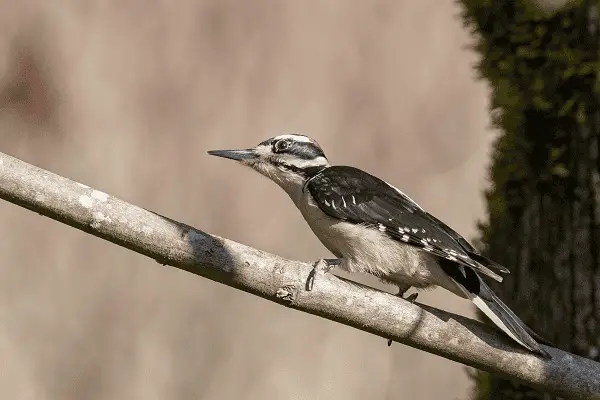
This bird is a bit bigger than the downy woodpecker. It uses its strong beak to make holes in trees for homes and to find food. It eats insects, spiders, and other small animals. Its loud “peek” call can be heard in the woods, adding to the area’s sounds.
| Woodpecker Species | Average Length |
|---|---|
| Hairy Woodpecker | 9-10 inches |
| Downy Woodpecker | 6-7 inches |
| Red-bellied Woodpecker | 9-10 inches |
| Pileated Woodpecker | 16-19 inches |
The hairy woodpecker is important in Michigan’s bird world. It helps keep the forests healthy by controlling insects and making homes for other animals.
3. Red-headed Woodpecker
In Michigan, the red-headed woodpecker is a standout among woodpeckers. Its bright red head and black and white body make it a sight to see. It lives in the southern parts of Michigan all year, in places like forests, swamps, and open woods.
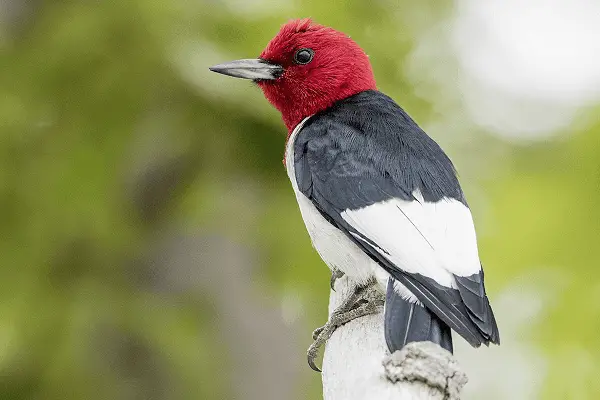
This bird is known for its quick flight and catching insects in mid-air. It’s also smart, using the same nest every year. The red-headed woodpecker eats fruits, seeds, and insects, making it a diverse eater.
The red-headed woodpecker adds to Michigan’s bird sounds with its unique call. It sounds like the red-bellied woodpecker but is deeper. This call makes the bird even more special in Michigan’s nature.
Unveiling the Unique Traits and Behaviors of This Striking Species
The red-headed woodpecker is amazing because of its looks and how it lives. Its bright feathers, quick flight, and varied eating habits make it stand out in Michigan’s nature.
| Trait | Description |
|---|---|
| Plumage | The red-headed woodpecker is the only woodpecker in eastern North America with a fully red head. This makes it very noticeable against its black and white body. |
| Foraging | This bird is great at catching insects in the air and also stores food for later. It’s very skilled at finding and preparing food. |
| Nesting | The red-headed woodpecker is special because it uses the same nest every year. This shows how adaptable and smart it is. |
The red-headed woodpecker is a special bird that brings color and life to Michigan’s birds. Its looks, skills, and fit into nature make it a bird worth celebrating.
4. Pileated Woodpecker
The pileated woodpecker is a standout among Michigan’s woodpeckers. It’s the largest woodpecker in North America. It has black feathers, a bright red crest, and a strong beak.
These birds live in most of Michigan’s forests. You can hear their loud, thunderous drumming for miles. It’s a sign they’re around.
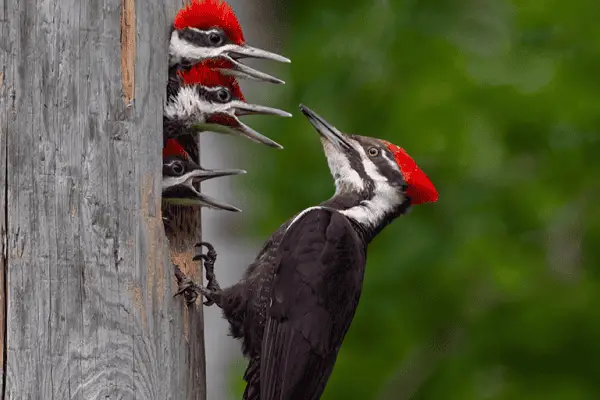
But they do more than just make noise. They help keep Michigan’s forests healthy. Their big holes in trees are homes for many animals, like owls, squirrels, bats, and insects.
Even though they look big and strong, pileated woodpeckers are gentle giants. They rarely get aggressive with people. They use their strong beaks to make nests and find food in trees.
Seeing these birds in Michigan’s forests is special. The pileated woodpecker shows how rich and diverse Michigan’s nature is. It reminds us why we need to protect our ecosystems.
5. Red-bellied Woodpecker
The Red-bellied Woodpecker is a common bird in Michigan, especially in the south. It’s a medium-sized bird known for being adaptable. It has a black-and-white back and a faint red belly. This bird lives not just in forests but also in suburban areas.

Adaptability and Resourcefulness
Woodpeckers are often thought of as forest birds, but the Red-bellied Woodpecker has made urban areas its home. These birds visit backyard feeders, where they can be seen on the sides of feeders or eating suet. They make Michigan neighborhoods more lively with their “churr” or “kwirr” calls.
This bird can find many types of food, from insects to fruits and berries. Its ability to adapt and nest in trees has helped it live in both rural and city areas. This makes it a common and welcome sight for bird lovers and homeowners.
| Backyard Feeder Species | Number of Species |
|---|---|
| Sparrows, Finches, and allies | 17 |
| Woodpeckers | 5 |
| Blackbirds | 4 |
| Doves | 1 |
| Mockingbirds and Thrashers | 2 |
| Bluebirds and Robins | 2 |
| Jays and Crows | 2 |
| Titmouse and Chickadees | 2 |
| Nuthatches | 2 |
| Wrens | 1 |
| Kinglets, Starlings, and Brown Creepers | 1 each |
The Red-bellied Woodpecker thrives in suburban areas, foraging, nesting, and interacting with other birds. Its ability to adapt shows its remarkable resourcefulness. This woodpecker enriches Michigan’s bird life, making it a part of the urban community.
6. Black-backed Woodpecker
In northern Michigan, a bird with a black back and white belly does well after wildfires. This is the black-backed woodpecker. It’s a medium-sized bird that loves the coniferous forests of Michigan.
This woodpecker is not very common in Michigan but is interesting because of its special home needs. It likes areas that have had fires recently. These fires bring lots of wood-boring beetle larvae to the dead trees.

Studies show that these woodpeckers live and hunt in areas after fires. In a study near Lake Tahoe, California, scientists found 77 nests of three woodpecker species, including the black-backed, in dead trees from a fire. Most of these nests were used by other animals the first year after they were made.
The woodpecker’s black back helps it hide in burned areas. But, these important homes can be short-lived. Half of the dead trees with nests fell within two years after the fire. Keeping more small dead trees could help the woodpeckers in the future.
The black-backed woodpecker is interesting to study and protect because of its unique ways and special home needs. It does well in areas after fires. Its survival is linked to the health of these forests.
7. Northern Flicker
In Michigan’s forests, the Northern Flicker is a standout with its “wick-a-wick-a-wick” call. It’s a large, striking woodpecker that loves to forage on the ground. It eats ants and beetles, thanks to its unique diet.
Its feathers are a mix of brown, black, and white, with yellow underwings that shine when it flies. This bird is a key part of Michigan’s bird world because of its special way of eating.

While other woodpeckers drill into trees, the Northern Flicker hunts on the ground. It uses its long, barbed tongue to catch ants. This unique behavior makes it stand out and helps balance the state’s woodlands.
In mid-April, the Northern Flicker’s calls fill the forests as they return from migration. Some stay to winter, but most travel far in the fall.
With over 160 nicknames, like “cotton-rump” and “yellow-hammer,” the Northern Flicker has won over many bird lovers in Michigan. Its looks, actions, and role in nature make it a fascinating bird.
| Statistic | Value |
|---|---|
| Percentage of migratory northern flickers in Ohio | Of Ohio’s six commonly occurring nesting woodpecker species, the northern flicker is the most migratory. |
| Peak window of fall migration for northern flickers | The peak window of fall migration for northern flickers is mentioned in the text. |
| Peak of spring migration for northern flickers | The flickers’ spring migration peaks in mid-April. |
| Percentage of northern flickers that stay to breed and overwinter in certain areas | Flickers do stay to breed and overwinter in certain areas. |
| Percentage of ants in the northern flicker’s diet | Ants form the bulk of the diet of northern flickers. |
| Characteristics of the northern flicker’s courtship call | Flickers deliver long series of Wicka-wicka calls during courtship rituals, and courting males may drum with short bursts of 25 beats a second. |
| Number of nicknames for the northern flicker | Flickers have at least 160 nicknames, with examples such as cotton-rump, high-hole, and yellow-hammer. |
Woodpeckers as Nature’s Engineers
Woodpeckers are key to Michigan’s ecosystems. They keep insect populations in check, making forests healthier. Their tree cavities become homes for many birds like owls and nuthatches. These cavities are vital for Michigan’s diverse wildlife.
Woodpeckers help balance Michigan’s forests. The Michigan Department of Natural Resources (DNR) works to protect wildlife habitats. They team up with groups like the National Wild Turkey Federation for conservation projects.
The DNR also helps endangered species like the Mississauga Rattlers and Karner blue butterflies. They manage their habitats by mowing and clearing trees. At Muskegon and Allegan State Game Areas, staff work hard to protect wetlands and plan for the future.
Check Our Previous Articles:
Frequently Asked Questions
Q1. What is the largest woodpecker in Michigan?
The Pileated Woodpeckers is the largest woodpecker in Michigan.
Q2. Do woodpeckers stay in Michigan for the winter?
Yes, many woodpeckers, including the Downy and Hairy Woodpeckers, stay in Michigan throughout the winter.
Q3. What is the rare woodpecker spotted in Michigan?
The rare woodpecker sometimes spotted in Michigan is the Red-cockaded Woodpecker.
Q4. Are there red-headed woodpeckers in Michigan?
Yes, Red-headed Woodpeckers can be found in Michigan.

